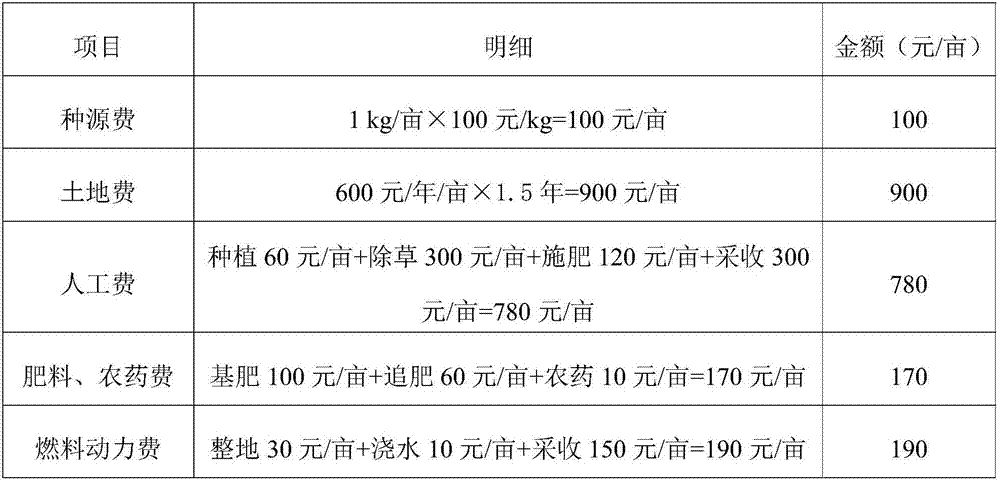Cultivation method of salviae miltiorrhizae for feeding
A cultivation method and technology of salvia miltiorrhiza, applied in the field of cultivation of salvia miltiorrhiza for feeding, can solve the problems of high production cost and unstable quality of salvia miltiorrhiza for feeding, and achieve the effects of reduced planting labor costs, easy learning and mastering, and simple operation
- Summary
- Abstract
- Description
- Claims
- Application Information
AI Technical Summary
Problems solved by technology
Method used
Image
Examples
Embodiment 1
[0039] (1) Site selection
[0040] Sandy loam soil (sandy soil content 60%) with deep soil layer (>1m), sunny terrain, good drainage, pH 7.5, and sufficient fertility was selected as the planting site, and the previous crop of the planting site was corn.
[0041] (2) Soil preparation
[0042] After the previous crops are harvested, the soil is prepared, and compound fertilizer is applied per mu (N:P 2 o 5 :K 2 (O=20:15:15) 50kg as base fertilizer, deep plow 40cm, deep plow the applied compound fertilizer into the soil and mix evenly, plow and rake finely, make a furrow with a furrow width of 150cm, open a drainage ditch 30cm wide and 20cm deep between the furrows.
[0043] (3) planting
[0044] Use live mode. In the first ten days of July of the first year, select mature and plump Salvia miltiorrhiza seeds for sowing, the sowing rate is 1.0kg / mu, and treat the seeds with 20mg / L gibberellin to soak for 10-15s before sowing (increase the emergence rate and emergence potenti...
Embodiment 2
[0060] Effects of Soil pH on Yield and Quality of Salvia Miltiorrhiza
[0061] Change the soil pH of the planting site in Example 1, select the soil with pH of 6.5, 7.0, 7.5, and 8.0 as the planting site respectively, the soil type is sandy loam with a sand content of 70%, and the base fertilizer ratio is N:P 2 o 5 :K 2 O=20:15:15, the sowing period is mid-July, and the harvest time is early November. Other parameters and conditions are the same as those in Example 1. The obtained Salvia miltiorrhiza yield and index component contents are shown in Table 3 below.
[0062] Table 3 Salvia miltiorrhiza yield and quality test results under different pH conditions
[0063] Numbering
[0064] It can be seen from the above table that when the soil pH is 6.5-8.0, the content of total salvia ketones can be above 0.6%, especially when the pH is 7.0-7.5, and the pH is more preferably 7.5. At this time, the total salvia miltiorrhiza The relative content and absolute content of...
Embodiment 3
[0066] Effects of Soil Types on Yield and Quality of Salvia Miltiorrhiza
[0067] Change the planting land soil type among the embodiment 1, select the sandy loam soil that sand content is 50%, 60%, 70%, 80% respectively as the planting land, soil pH7.0, basal manure proportioning is N:P 2 o 5 :K 2 O=20:15:15, the sowing time is mid-July, and the harvest time is early November. Other parameter conditions are the same as those in Example 1. The obtained Salvia miltiorrhiza yield and index component contents are shown in Table 4 below.
[0068] Table 4 Yield and quality inspection results of Salvia miltiorrhiza in different soil types
[0069]
[0070]
[0071] It can be seen from the above table that when the soil sand content is 50-80%, the content of total salvia ketones can be above 0.6%, and the sandy loam soil with a sand content of 60% is most suitable for direct seeding of salvia miltiorrhiza. Higher in ketones.
PUM
 Login to View More
Login to View More Abstract
Description
Claims
Application Information
 Login to View More
Login to View More - R&D
- Intellectual Property
- Life Sciences
- Materials
- Tech Scout
- Unparalleled Data Quality
- Higher Quality Content
- 60% Fewer Hallucinations
Browse by: Latest US Patents, China's latest patents, Technical Efficacy Thesaurus, Application Domain, Technology Topic, Popular Technical Reports.
© 2025 PatSnap. All rights reserved.Legal|Privacy policy|Modern Slavery Act Transparency Statement|Sitemap|About US| Contact US: help@patsnap.com



